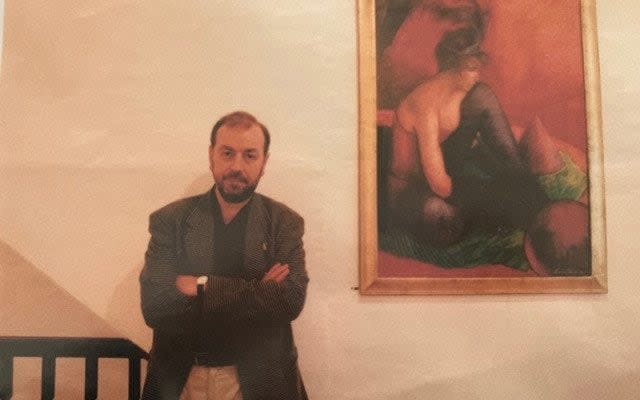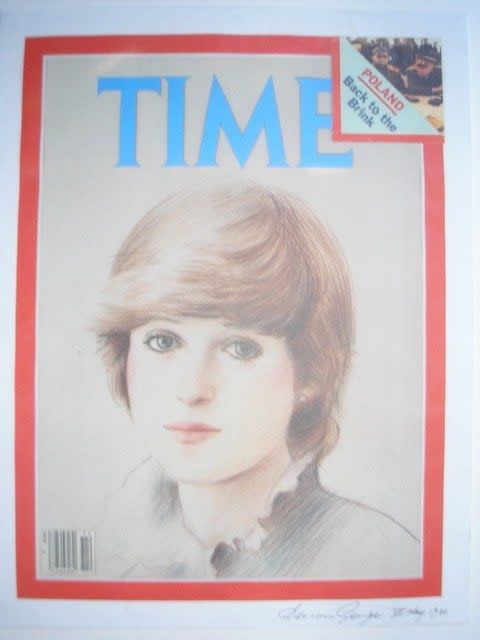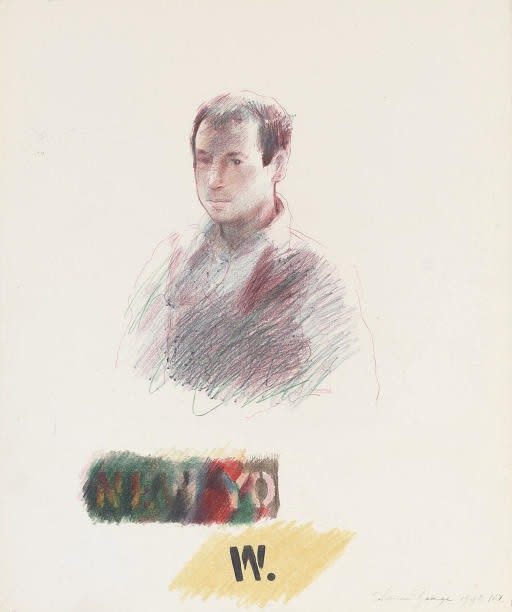Adrian George, illustrator and portraitist whose work ranged from postage stamps to magazine drawings – obituary

- Oops!Something went wrong.Please try again later.
- Oops!Something went wrong.Please try again later.
Adrian George, who has died aged 76, was an artist and illustrator who worked in oils, watercolour and prints, but it was for his pastels and drawings, with their distinctive feathery cross-hatching, that he became best known.
Examples of George’s work are held in the Royal collection, in the V & A and the National Portrait Gallery – which commissioned portraits of William Golding and Arthur C Clarke – and in the Vatican.
He exhibited around the world, and regularly in London, his solo shows generally having a narrative element: “Nuits Blanche” (Francis Kyle Gallery, 1988) featured images of Parisian life in summer; “The South Seas” (Francis Kyle Gallery, 1990) drew on his travels in French Polynesia.
Youthful, subversive and bohemian, George travelled the world and was fascinated by religions and mysticism, but remained at heart a pragmatist, once describing himself as “the T S Eliot of artists [working] like a bank clerk in my studio”.
He designed posters for the Proms; wrote travel stories with drawings for newspapers; drew Pope John Paul II for a record of highlights of the Pontiff’s visit to Britain in 1982; did title sketches for The Spectator’s food experts Digby Anderson and Jennifer Paterson (restaurant meals were thrown in), and developed a reputation for portraits of women.
Adrian George’s work became familiar to a wider public in the 1980s with two sets of stamps commissioned by the Post Office. His 1982 “Theatre Stamps” series, featuring archetypes from the performing arts, won a series of prizes at an international competition in Italy, including “The Most Beautiful Stamp in the World”.
In 1985 his “Christmas Pantomime” series, including (unbeknown to the Post Office) a self portrait of the artist as Widow Twankey, was awarded the Phillips Gold Medal for stamp design.
George’s sitters included David Hockney, Mary Quant, Germaine Greer, Peter Sellers and Marianne Faithfull. In 1981 Time magazine commissioned him to draw Lady Diana Spencer for the cover of an issue marking her engagement to the Prince of Wales.

The drawing depicted, as George put it, the “inner sadness within her even then, at that time of compulsory smiling”, and in the celebratory mood of the time was never used. However, gallery-goers could contemplate the portrait with the benefit of hindsight in 2005 when it was shown at the solo exhibition “Carnival of Desire” at the Chris Beetles Gallery in St James’s.
Adrian George was born on June 27 1944 in Cirencester, where his parents were sheltering from the war. They returned to London a few years later, to the rough and tumble of Willesden, where Adrian remembered playing on bomb sites. He later attended Preston Manor grammar school while his father commuted from Metroland to a chemist’s shop in Kensington, grinding potions for T S Eliot.
Adrian was three when his first work, a painting of a pig, was put on show – on the wall at his nursery school – and praised. “I have never quite escaped from that feeling of pleasure in seeing my work exhibited,” he told The Daily Telegraph in 1992.
He trained at the Harrow School of Art and, from 1964 to 1967, at the Royal College of Art. His love of travel was sparked aged 17 when he hitch-hiked round Europe. In 1965, when he was 20, he sold some drawings he made on a visit to Tangier to Queen magazine, launching his career as an illustrator.
In his first year at the Royal College, he bought an attic flat in Bayswater and was introduced to the enchantments of Notting Hill by the artist Peter Blake, who had taught him in Harrow.
“I seemed to spend my time in Rolls-Royces being driven to slum basements,” he recalled in a short sketch. “The 1960s kaleidoscoped into the 1970s; my indistinct memories reveal gangsters and fey pop stars, Joe Boyd, a record producer of Jimi Hendrix, playing games of poker with people on the run.
“Fashion designers and boutiques … embryonic pop stars like Marc Bolan or Brian Ferry or Nick Drake always seemed to be in the corners of rooms at parties and night clubs”, and one might find “the lovely orchidaceous Patrick Procktor, and amongst the catamites and their masters, pretty girls like sweet Marinka and the charming Celia Birtwell …”
The fashion designer Celia Birtwell became both a muse and George’s lover. She was married at the time to fellow fashion designer Ossie Clark, with whom she had two small sons, but had become fed up with the prolonged absences of her husband who, high on amphetamines and distracted by affairs with men and women, would disappear for days.
When Clark learnt in 1973 that Celia was having an affair with George, he punched her on the nose, whereupon she took their sons and sought refuge with David Hockney.
Despite such distractions, George turned out work at a punishing rate. He did a promotional poster for The Who’s album The Who Sell Out (1967) – which was, much to his delight, reissued earlier this year – and worked on a film for 20th Century Fox.
In addition, “there were drawings for magazines like The Sunday Times under Harold Evans and Nova for Molly Parkin and also ‘underground’ magazines like Oz through Felix Dennis and also radical theatre with Philip Prowse at the Glasgow Citizens. Everything seemed to happen at once. And then there was travel … travels in Europe and travels around America.”

In 1977, on the Train Bleu to the South of France, where he had been commissioned to do drawings for Radio Times, he met the journalist Glenys Roberts and for several years they travelled together all over the world and brought up her daughter Polly by her former husband, the Mayfair tailor Doug Hayward, and George’s son Josh, from his first marriage, to Jill Koerner.
In 1987, with the proceeds of “Adrian George in Arcadia” at the Francis Kyle gallery, he bought a flat off the Rue Dauphine in Paris, where he and his young muse, and later wife, Amanda Monypenny, based themselves for the next 13 years.
For George, the attractions of Paris included “fromage and gossip and costume parties … Elegant lesbians and the legacy of Napoleon Bonaparte … The public use of the colour green and stealing ashtrays.” He once threw a South Seas costume party that went on for a week, but he never perfected his French because, he explained, he loved listening to people talking at bus stops: “They are probably whingeing about back pain, but I think they are talking about Proust.”
When the Francis Kyle Gallery asked him to contribute to an exhibition entitled “Art and Memory: Contemporary Painters in Search of Marcel Proust”, he submitted Monsieur is Afraid of the Scent of Princesses, painted on cork because the asthmatic Proust wrote his great novel in a cork-lined room to keep out the noise and dust. It was also an homage to a real princess, George’s friend Princesse Henri de Bavière, holder of infamous salons in her Proustian Parisian home.
In 1994, Adrian wrote a book, Paris in August, published by Peter Owen. It was an illustrated diary of Parisian life during the sleepy month of August. Suzanne Lowry in The Daily Telegraph observed how “his glittering, ironic eye drinks in the beauty, the colours and the nonsense around him …”
George was a keen classicist and, as John Russell Taylor noted in 2005, “a sophisticated observer, an unusually literate reader in other cultures … If anyone today manages to live such an Arcadian dream it must surely be Adrian George.”
Throughout his time in Paris, George kept a studio in Kensington Church Street, and in 2000 he and Amanda returned to London for their sons to be educated.
She survives him with their two sons, Jack Apollo and Joe Bacchus, and his son Josh from his first marriage.
Adrian George, born June 27 1944, died May 22 2021

